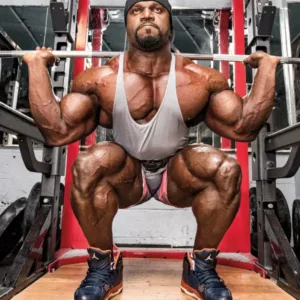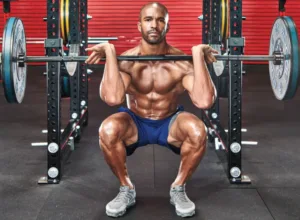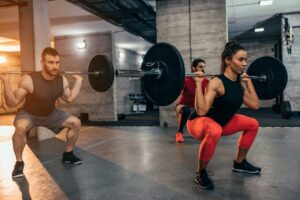The squat. A simple movement, yet a cornerstone of strength training. It works a multitude of muscle groups, from your quads and glutes to your core and hamstrings, making it a true full-body exercise. But mastering the squat goes beyond just loading up a barbell and going down low. Proper form is crucial to maximize results and avoid injuries.
The squat is considered a compound movement, meaning it works for multiple muscle groups across multiple joints. The primary muscles involved in the movement are your quadriceps (the muscles in the front of your thighs) and your glutes (your butt muscles), Tamir says.
On the eccentric part of the move or the lowering portion of the squat, the muscles in your hamstrings and your hip flexors fire too. Squats also work the muscles around the knee, which helps build strength and prevent injury, he says.
Throughout the move, your core muscles fire in order to keep you steady.
“Your abdominals are stabilizers,” he says. “So they assist in weight-bearing movements.” Strong core muscles are important because not only do they help you with your lifts, but they also reduce the risk of lower back pain.
If you do a weighted squat—whether using a dumbbell in a goblet squat, two dumbbells in a front squat, or a barbell in either a back or front squat—“you’re also working your upper body. That’s because the move requires an isometric holding of weight, a static muscle contraction without any movement”, Tamir says.
Weighted squats, like other forms of load-bearing physical activity, also benefit your bones: “They help you build stronger bones, he says, which can help prevent osteopenia or osteoporosis as you get older”.
Plus, since a proper squat requires mobility in your hips and ankles, you can also consider squatting a mobility exercise that can help you move better, Tamir says.
If we were asked to name an exercise that is the illest-performed in the gym – it would have to be the squats. It’s no secret that squats are one of the most beneficial and important exercises when it comes to building muscle mass and improving functional strength.
While many people take the right step of incorporating the compound exercise into their training program, only a few take out the time to learn the correct way of performing the squats.

 Here’s your comprehensive guide to improve your squat skills and elevate your workouts!
Here’s your comprehensive guide to improve your squat skills and elevate your workouts!
Understanding Squat Mechanics
Before diving into technique, let’s break down the basic mechanics of a squat. There are three main phases:
-
The Setup: Stand shoulder-width apart with your toes slightly pointed outward (around 15-30 degrees). Engage your core by pulling your belly button towards your spine. Maintain a neutral spine with a slight arch in your lower back. Reach your arms out in front of you for balance.
-
The Descent: Keeping your core tight and back straight, initiate the movement by pushing your hips back as if you’re about to sit in a chair. Simultaneously, bend your knees, lowering your body down. Imagine your knees tracking over your toes and avoid letting them cave inward.
-
The Ascent: Once your thighs reach parallel to the ground (or slightly lower for experienced lifters), push through your heels to drive yourself back up to the starting position. Squeeze your glutes at the top of the movement for maximum activation.
Perfecting Your Squat Form: Key Points
Now that you understand the basic mechanics, let’s delve into some key points to ensure proper form:
-
Foot Position: Experiment with different toe placements to find what feels most comfortable and stable for you. A wider stance can provide more stability for beginners, while a narrower stance may be preferred by more advanced lifters.
-
Knee Tracking: Ensure your knees track in line with your toes throughout the movement. Avoid letting them cave inward, as this can put strain on your knees.
-
Back Position: Maintain a neutral spine throughout the squat. Don’t round your back, as this can lead to injury. If you struggle to keep your back straight, try using a lighter weight or practicing air squats (squatting without weight).
-
Depth: Aim to squat low enough so your thighs are at least parallel to the ground. However, don’t force depth if it compromises your form.
-
Core Engagement: A strong core is essential for stabilizing your spine and maintaining proper form. Brace your core by pulling your belly button towards your spine throughout the movement.
-
Heel Drive: Focus on pushing through your heels to initiate the movement back up to the starting position. This helps activate your glutes and hamstrings effectively.
Progression and Variations
As your squat form improves and strength increases, you can gradually progress by:
-
Increasing Weight: Once you can perform a certain number of sets and repetitions with good form, consider increasing the weight on the barbell. Start with small increments to avoid overloading your muscles.
-
Adding Tempo: Slowing down the movement (both descent and ascent) can increase muscle engagement and improve technique. Try a 4-second descent, 2-second pause at the bottom, and a 4-second ascent.
-
Incorporating Variations: There are many squat variations that target different muscle groups and can add variety to your workouts. Some popular options include front squats, Bulgarian split squats, and goblet squats.
Check Out Our List Of The Best Supplements For Building Muscle, Shredding Muscle, Recovery, And Great Health, and Wellness Products! Purchase ifbnewsfeed.org‘s apparels Here: ifbnewsfeed.org

 Start Right
Start Right
The squats start before you get under the bar. How and where you place the bar on your shoulders can determine the quality of the exercise. High and low bar positions are the two most popular ways of placing the barbell on your back.
The high bar is generally used by bodybuilders and/or average height individuals. Whereas, the low-bar position is used by powerlifters or taller people. Both can take time to get used to. We recommend picking the one you’re comfortable with and sticking with it.
Mind Your Step
Most people make the mistake of unracking the barbell in a lunging position. Both your feet should be under the bar as you go for the lift-off. While the foot placement might not make a difference in the beginning, it’ll prove its worth as you lift heavier weights.
Once the bar is unracked, you need to get in position by your second step. The first step-back should be to get at a comfortable distance from the rack, and the second should be to get in position for the squat. Don’t lift off the bar and take 5-10 steps to get in position.
Many people don’t know the correct foot placement while squatting. They either keep their feet too close or too wide. In a normal squat, your feet should be directly under your shoulders and pointing at 1’o clock.
Squats Not Good Mornings
We’re sure you know someone who bends forward while performing the squats so much so that their upper body is almost parallel to the floor at the bottom of the movement. If you can’t help but lean forward while squatting, you should consider dropping down the weights.
Another trick is to keep your chest out and look at the ceiling. Forcing your upper body to remain straight throughout the lift can take some getting used to. Warming up and stretching before squatting can also help improve your form.
Breathe Right
Breathing is one of the most overlooked aspects of working out. If you’re not already using controlled breathing in your workouts, you’re leaving gains on the table. Also, using controlled breathing while squatting isn’t as simple as breathing in while going down and breathing out while coming up.
To make the most of the exercise, you should take a deep breath at the top of the movement and hold your breath as you squat down. Exhale sharply as you return to the starting position.
Use Accessories
Using accessories like the gym belt and knee wraps can take your squatting game to the next level. A weight lifting belt combined with the new breathing technique you just learned can help you generate an incredible amount of thoracic pressure.
The knee wraps keep your joints tight and can help with generating a little push on the concentric motion. Wrist wraps, barbell pads, and weightlifting shoes are some other great accessories you should consider investing in.
 Safety Tips and Additional Considerations
Safety Tips and Additional Considerations
Here are some additional points to keep in mind for safe and effective squatting:
-
Warm Up Properly: Before squatting with weight, perform a dynamic warm-up to prepare your body for the exercise. This may include light cardio, mobility exercises, and air squats.
-
Listen to Your Body: Don’t push yourself beyond your limits. If you experience any pain, stop the exercise and consult a healthcare professional.
-
Consider Coaching: If you’re a beginner or unsure about your form, consider working with a certified personal trainer who can provide personalized guidance.
Building Your Squat Mastery: A Final Note
Squatting is a journey, not a destination. Mastering the squat takes time, practice, and dedication. By focusing on proper form, utilizing progressive overload, and incorporating variations, you can unlock the full potential of this powerful exercise. Remember, consistency is key! So lace up your shoes, grab the barbell (or your bodyweight), and get ready to elevate your squat game!
More About Build Bigger, Stronger Legs with Dumbbells Contents
- The Best “10 Must-Do Leg Workouts And Exercises” You Shoulder Consider To Apply Them In Your Legs Day
- The “3 Outer Quad Exercises” for Sculpted Legs & Tips for Building Strong and “Massive Outer Quadriceps”
- Build Up Insane And Shredded Legs (Quads & Hamstrings) With These “5 Best Dumbbell Exercises”

- Get $200 With Your 1st Order Because Your Health Matters
- Best Supplements For Muscle Building, Strength & Champion Performance
- Best Supplements For Intense Energy, Performance & Endurance
For More News And Daily Updates, Follow IFBNewsfeed.Org on Facebook, Twitter, and Instagram. Comment, Like, And Share With Everyone Who May Need To Be Updated With The Most Recent Fitness/Bodybuilding/Powerlifting And CrossFit News.







